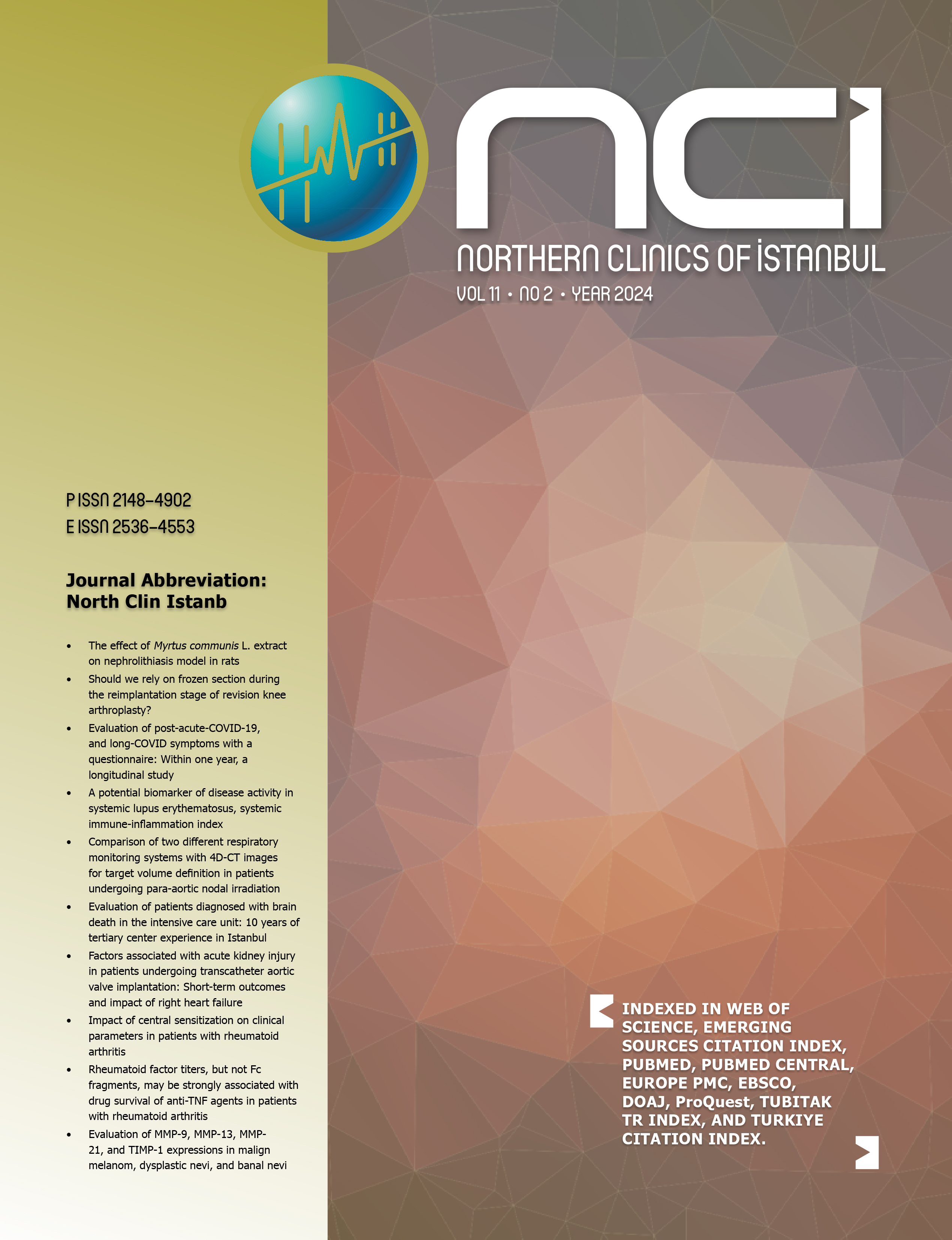Investigation of double-carbapenem efficiency in experimental sepsis of colistin-resistant Klebsiella pneumoniae
Imran Kosar1, Gokcen Dinc2, Esma Eren3, Yusuf Aykemat4, Mesut Kilic5, Huseyin Kilic1, Mehmet Doganay61Department of Medical Microbiology, Erciyes University Faculty of Medicine, Kayseri, Turkey2Department of Medical Microbiology, Erciyes University Faculty of Medicine, Kayseri, Turkey; Department of Molecular Microbiology, Erciyes University Genome and Stem Cell Centre, Kayseri, Turkey
3Department of Infectious Diseases and Clinical Microbiology, Erciyes University Faculty of Medicine, Kayseri, Turkey
4Faculty of Health Science, Nuh Naci Yazgan University, Kayseri, Turkey
5Department of Internal Medicine, Kayseri City Hospital, Kayseri, Turkey
6Department of Infectious Diseases and Clinical Microbiology, Lokman Hekim University Faculty of Medicine, Ankara, Turkey
OBJECTIVE: Klebsiella pneumoniae, a Gram-negative pathogen, especially which produces carbapenemase, is seen as a major threat to public health due to rapid plasmid-mediated spread of resistance and limited therapeutic options available for treatment. Although colistin has been recognized as a last resort antimicrobial for multidrug-resistant K. pneumoniae infections, these isolates have developed resistance to colistin as a result of its intensive use. The aim of this study was to evaluate the efficacy of double-carbapenem treatment of colistin-resistant K. pneumoniae experimental sepsis in mice.
METHODS: In the study, 810-week-old Balb-c mice were divided as control groups (positive and negative) and treatment groups (colistin, ertapenem+meropenem, and ertapenem+meropenem+colistin). Sepsis was developed in mice by an intraperitoneal injection of colistin resistant K. pneumoniae. Antibiotics were given intraperitoneally 3 h after bacterial inoculation. Mice in each subgroup were sacrificed with overdose anesthetic at the end of 2448 h and cultures were made from the heart, lung, liver, and spleen. Furthermore, homogenates of lung and liver were used to detect the number of colony-forming units per gram. Bacterial clearance was evaluated in lung and liver at different time points.
RESULTS: When the quantitative bacterial loads in the lung and liver tissues are evaluated, no statistically significant difference was observed between different antibiotic treatments (p>0.05). All three treatment options were not effective, especially in 24 h. Only the decrease in bacterial load at the 48th h of the group treated with ertapenem + meropenem + colistin was found significant (p<0.05) compared to the 24 h.
CONCLUSION: In the light of these data, it was understood that double-carbapenem application was not sufficient in the treatment of experimental sepsis in mice with colistin-resistant K. pneumoniae. Furthermore, ertapenem + meropenem + colistin combined therapy was not found to be superior to colistin monotherapy or double-carbapenem therapy.
Keywords: Colistin resistance, experimental sepsis; Klebsiella pneumoniae.
Kolistin dirençli Klebsiella pneumoniae deneysel sepsisinde çift karbapenem etkinliğinin araştırılması
Imran Kosar1, Gokcen Dinc2, Esma Eren3, Yusuf Aykemat4, Mesut Kilic5, Huseyin Kilic1, Mehmet Doganay61Erciyes Üniversitesi Tıp Fakültesi Tıbbi Mikrobiyoloji Anabilim Dalı, Kayseri2Erciyes Üniversitesi Tıp Fakültesi Tıbbi Mikrobiyoloji Anabilim Dalı, Kayseri; Erciyes Üniversitesi Genom ve Kök Hücre Merkezi Moleküler Mikrobiyoloji Anabilim Dalı, Kayseri
3Erciyes Üniversitesi Tıp Fakültesi, Enfeksiyon Hastalıkları ve Klinik Mikrobiyoloji Anabilim Dalı, Kayseri
4Sağlık Bilimleri Fakültesi, Nuh Naci Yazgan Üniversitesi, Kayseri
5Kayseri Şehir Hastanesi, İç Hastalıkları Kliniği, Kayseri
6Lokman Hekim Üniversitesi Tıp Fakültesi, Enfeksiyon Hastalıkları ve Klinik Mikrobiyoloji Anabilim Dalı, Ankara
Amaç: Gram-negatif bir patojen olan K. pneumoniaenın özellikle karbapenemaz üreten türleri, hızlı plazmid aracılı direnç yayılımı ve tedavi için sınırlı terapötik seçenekler nedeniyle halk sağlığı için büyük bir tehdit olarak görülmektedir. Kolistin, çoğul ilaç dirençli K. pneumoniae enfeksiyonları için bir "son çare" antimikrobiyal olarak kabul edilmiş olmasına rağmen, bu izolatlar yoğun kullanımı nedeniyle kolistine direnç geliştirmiştir. Bu çalışmanın amacı, farelerde kolistin dirençli K. pneumoniae deneysel sepsisinde çift karbapenem tedavisinin etkinliğini değerlendirmektir.
Metod: Çalışmada 8-10 haftalık Balb-c fareler kontrol grubu (pozitif ve negatif) ve tedavi grubu (kolistin, ertapenem + meropenem, ertapenem + meropenem + kolistin) olarak ayrıldı. Sepsis, farelerde kolistin dirençli K. pneumoniae'nin intraperitoneal enjeksiyonu ile geliştirildi. Antibiyotikler, bakteriyel inokulasyondan 3 saat sonra intraperitoneal olarak verildi. Her alt gruptaki fareler 24 ve 48 saat sonunda yüksek doz anestezi ile sakrifiye edilerek kalp, akciğer, karaciğer ve dalaktan ekim yapıldı. Ayrıca, akciğer ve karaciğer homojenizatları gram başına koloni oluşturan birim (cfu/gr) sayısını belirlemek için kullanıldı. Akciğer ve karaciğerde bakteriyel klirens farklı zaman noktaları için değerlendirildi.
Bulgular: Akciğer ve karaciğer dokularındaki kantitatif bakteriyel yükler değerlendirildiğinde; farklı antibiyotik tedavileri arasında istatistiksel olarak anlamlı bir fark gözlenmedi (p ˃0.05). Her üç tedavi seçeneği de özellikle 24 saat içinde etkili bulunmadı. Ertapenem + meropenem + kolistin ile tedavi edilen grubun sadece 48. saatindeki bakteri yükündeki azalma 24 saat ile karşılaştırıldığında anlamlı bulundu (p <0.05).
Sonuç: Bu veriler ışığında, farelerde kolistin dirençli K. pneumonia deneysel sepsis tedavisinde, çift karbapenem uygulamasının yeterli olmadığı anlaşıldı. Ayrıca, ertapenem + meropenem + kolistin kombine tedavisinin, kolistin monoterapisine veya çift karbapenem tedavisine göre bir üstünlük sağlamadığı belirlendi. (NCI-2020-0228.R1)
Anahtar Kelimeler: Kolistin Direnci, Deneysel Sepsis, Klebsiella pneumoniae
Manuscript Language: English





















